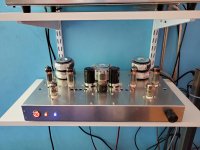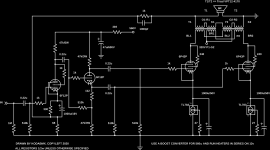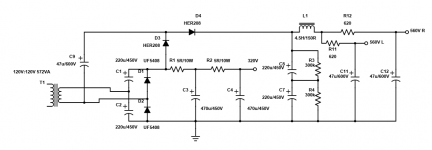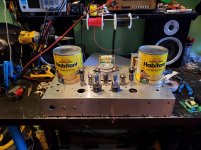Hi guys,
I've built numerous tube amps for guitar in all fashion: pcb, point to point, turrets etc.
My dad is always fascinated by my amps because he has always been an 'audiophile' and in his youth he started to work in an audio repair shop and always loved to mess with amplifiers.
Now that I have some free time and no commission to build I'd love to build a small stereo tube amp for my dad, do you have any suggestion?
I'm still in doubt between building a tube pre-amp + mosfet power amp or a full tube one.
I'm aiming at a bedroom level ampli, so not a very powerful one.
thanks a lot!
I've built numerous tube amps for guitar in all fashion: pcb, point to point, turrets etc.
My dad is always fascinated by my amps because he has always been an 'audiophile' and in his youth he started to work in an audio repair shop and always loved to mess with amplifiers.
Now that I have some free time and no commission to build I'd love to build a small stereo tube amp for my dad, do you have any suggestion?
I'm still in doubt between building a tube pre-amp + mosfet power amp or a full tube one.
I'm aiming at a bedroom level ampli, so not a very powerful one.
thanks a lot!
What is the signal source?
2 Vrms from a CD player is one thing.
500 mVrms from a phono preamp is another (-12 dB).
How much gain is needed?
What is the speaker efficiency?
For bedroom listening, either a simple 2 stage single ended, or a simple 2 stage push pull will have more than enough gain and power to meet the need.
Triode wired Pentode or Triode wired Beam Power in either SE or push pull.
Then a triode driver for SE, and a dual triode with current source to split and drive the outputs. No negative feedback needed for triode wired and low to moderate power levels. Individual self bias on the outputs.
Push Pull transformers will be smaller and lighter than SE.
Simple, not too much heat, not too big, little to go wrong or have to adjust.
2 Vrms from a CD player is one thing.
500 mVrms from a phono preamp is another (-12 dB).
How much gain is needed?
What is the speaker efficiency?
For bedroom listening, either a simple 2 stage single ended, or a simple 2 stage push pull will have more than enough gain and power to meet the need.
Triode wired Pentode or Triode wired Beam Power in either SE or push pull.
Then a triode driver for SE, and a dual triode with current source to split and drive the outputs. No negative feedback needed for triode wired and low to moderate power levels. Individual self bias on the outputs.
Push Pull transformers will be smaller and lighter than SE.
Simple, not too much heat, not too big, little to go wrong or have to adjust.
Last edited:
I built my dad a 10W trioded CCS biased PP 6P43P amp and he likes it a lot.
Uses 2 6F12P, 4 6P43P biased with TL783, and a 12SN7 for first gain/volume.
Total build cost was about 300$CAD
PT is 100VA, not 572VA... OPTs are VPT12-2080, not VPT12-4170. I used a 12 SMPS for the heaters, and a boost converter for the 560V instead of the quadrupler supply in the schematic, but you can do what makes you happy 🙂
The choke is 5$CAD at a1parts.com It's "Coil-58".
Point to point wired.
Koda
Uses 2 6F12P, 4 6P43P biased with TL783, and a 12SN7 for first gain/volume.
Total build cost was about 300$CAD
PT is 100VA, not 572VA... OPTs are VPT12-2080, not VPT12-4170. I used a 12 SMPS for the heaters, and a boost converter for the 560V instead of the quadrupler supply in the schematic, but you can do what makes you happy 🙂
The choke is 5$CAD at a1parts.com It's "Coil-58".
Point to point wired.
Koda
Attachments
Last edited:
PCB or point to point is probably the first question. Do you have a chassis in mind?
I'll prefer point to point.
excellent question! I need to enquire a bit more on that.6A3sUMMER said:What is the signal source?
2 Vrms from a CD player is one thing.
500 mVrms from a phono preamp is another (-12 dB).
kodabmx said:I built my dad a 10W trioded CCS biased PP 6P43P amp and he likes it a lot.
Uses 2 6F12P, 4 6P43P biased with TL783, and a 12SN7 for first gain/volume.
this looks promising already, thanks a lot! It's a nice starting point and what great job you did!
Thank you.
That design has a preamp and poweramp in the same chassis effectively. It's an "integrated amp" so it doesn't matter the signal source since there's more than enough gain.
The volume control attenuates below half volume, and boosts it above half volume.
If you're interested, you can use two 6S2S (6J5) instead of the single 12SN7 since it might be less money for the tubes.
Oh, and if you don't mind poor LF (20% power at 30Hz) you can use only one transformer per channel instead of the two interleaved ones. Effectively by connecting two as shown you make two 230V:12V @ 50Hz transformers into a single 480V:24V @ 25Hz coil (that still cancels DC flow). Thanks again to MaxHifi for the idea!
If your dad doesn't listen to modern electronic music, or organ music etc, you might not notice the difference in frequency response...
That design has a preamp and poweramp in the same chassis effectively. It's an "integrated amp" so it doesn't matter the signal source since there's more than enough gain.
The volume control attenuates below half volume, and boosts it above half volume.
If you're interested, you can use two 6S2S (6J5) instead of the single 12SN7 since it might be less money for the tubes.
Oh, and if you don't mind poor LF (20% power at 30Hz) you can use only one transformer per channel instead of the two interleaved ones. Effectively by connecting two as shown you make two 230V:12V @ 50Hz transformers into a single 480V:24V @ 25Hz coil (that still cancels DC flow). Thanks again to MaxHifi for the idea!
If your dad doesn't listen to modern electronic music, or organ music etc, you might not notice the difference in frequency response...
Last edited:
Looks creepy. Two stacks of two toroids abouve each other, never seen such a thing and it's no good design practise. There is no need for either, thats why nobody comes to those ideas.
And the funny part: the chassis would have been wide enough to put the two side by side. Only amateur designers could come to those strange design conclusions.
At least, cover it up but never let it be seen by any other listener what you've done.
And the funny part: the chassis would have been wide enough to put the two side by side. Only amateur designers could come to those strange design conclusions.
At least, cover it up but never let it be seen by any other listener what you've done.
Last edited:
Two stacks of two toroids abouve each other, never seen such a thing and it's no good design practise.
It is an easy way to make a P-P OPT for cheap. The pair in close contact are used in the same output stage to drive the same speaker, so coupling is not an issue.
It could be argued that the aesthetics are less than pleasing, but there are ways to make the ugly stack less ugly. The obvious is to use a large soup can for a cover, or fashion a box for all the toroids.
In one of my oddball guitar amps I capitalized on the ugly theme. I had used a pair of medical isolation transformers that each had 4 X 120 V windings. All 8 windings were used as interleaved primaries and a common secondary was wound through the core of the stacked toroids using white 16 gauge hookup wire.
I interspersed Electro Luminescent wire in three different colors with the secondary. EL wire works like a neon tube, almost no light is produced until a threshold voltage is reached, at which point it lights up. Then brightness varies with applied voltage. Each color was wired to the plate of an output tube through an LC filter, thus responding to a different range of frequencies.
This whole thing was called the "Tubelab Sonic Reactor" two core version. Turning the amp up to 11 and thrashing the guitar resulted in a "core meltdown" of multi colored light. The volume knob's full clockwise setting was labeled "meltdown." Yes, there were RGB LED's under each tube socket too. They also got some modulation from the speaker output.
I sold that amp for too much money to someone who thought it was cool. The design was basically a "Marshall 18 watt" clone.
I still have the dumpster toroids and the EL wire to build a 4 core Sonic Reactor in a box somewhere, but my engineering career came to an abrupt end 6 years ago and two house moves totaling 1200 miles has left a lot of stuff misplaced, and possibly lost forever.
That's your (unsolicited) opinion, Schmitz. If you don't like the layout and design, don't build one like this.
The amp I BUILT for MY FATHER and the one the OP might want to build for his really doesn't concern you, especially if you have nothing constructive to say or add.
I suggest you keep your opinions to your damned self.
The amp I BUILT for MY FATHER and the one the OP might want to build for his really doesn't concern you, especially if you have nothing constructive to say or add.
I suggest you keep your opinions to your damned self.
Last edited:
Well Schmitz77 is apparently pretty opinionated, FWIW I thought it was damned clever and a great/imaginative use of inexpensive parts to achieve the goal. This in my view is what good original engineering is all about.
My mom used to say if you don't have anything nice to say don't say anything at all. Words to live by particularly around here.
My mom used to say if you don't have anything nice to say don't say anything at all. Words to live by particularly around here.
For me, I like the look; it has a bit of a scientific appearance. Super clean with a nice layout.
For me, I like the look; it has a bit of a scientific appearance. Super clean with a nice layout.
Thanks! Ya, the unfinished aluminum kind of reminds me of 50's test equipment or something.
It could be argued that the aesthetics are less than pleasing, but there are ways to make the ugly stack less ugly. The obvious is to use a large soup can for a cover, or fashion a box for all the toroids.
I present to you "L'amplicateur du Soupe aux Pois"
Just a mock up. They are still cans of soup at this point 😀
Attachments
Last edited:
That's quite clever having two toroids to make a cheap OPT. Do they work up to 20KHz OK - I guess they did.
Does not sound much different from buying a specialist OPT at a fraction of the price. I suppose your limited to a max HT mind most have good breakdown voltages being mains. Somebody at work suggested a built a guitar pre-amp with the mains transformer from an old shaver socket and put some turns for the heaters around it.
Last edited:
The transformers are hipot tested to 4kV, and the way they are wired, they effectively make a 480V@25Hz coil good for 25VA. All the amps I have designed use ~300V B+ for the trioded power stage, so all is good, even with the magnetic swings. My monoblocs use a pair of 250VA coils and will put out 112WRMS into 6R @ 30Hz sine drive. These amps (PPP 6P45S) will peak 1.4A on the primary side (which has a DCR of only 12 ohms for both coils interleaved).
I thought about the heater winding trick, but I find it cheaper and easier to just use a cheap SMPS instead.
I thought about the heater winding trick, but I find it cheaper and easier to just use a cheap SMPS instead.
Do they work up to 20KHz OK - I guess they did.
When you use line / mains transformers as OPT's they may or may not work well, and there could be rolloff on the HF end due to winding capacitance, and at the LF end due to lack of sufficient primary inductance and core saturation. Testing is the only to find out.
As stated, driving these transformers from the lowest possible source impedance will help "swamp" these issues.
I got a bunch of "medical grade" power conditioners out of a dumpster in a warehouse complex. They consisted of the 4 winding isolation transformers, some gas tube and MOV surge suppressors, a couple common mode chokes and some caps. I removed the toroid, and tossed the rest back into the trash.
The units were all the same, but the toroids appeared to be from two different vendors. One kind worked batter than the other, and I tried all usable combinations of the 8 "primaries" to choose the best results. Each toroid must use an equal number of windings from each output tube so that the DC will cancel.
When using isolation transformers with an added secondary it is also best to have the windings connected to the tube plates to be from opposite sides of the original primary / secondary. The insulation from primary to secondary is usually far better than that from primary to other primary. At least 2 X B+ voltage will be seen between these windings, often a lot more in an overdriven guitar amp.
That's your (unsolicited) opinion, Schmitz. If you don't like the layout and design, don't build one like this.
The amp I BUILT for MY FATHER and the one the OP might want to build for his really doesn't concern you, especially if you have nothing constructive to say or add.
I suggest you keep your opinions to your damned self.
I think it looks great, and for anyone who knows how things work without having to be stuck to a textbook, it is brilliant. You know, the less one know more they think they know it all!!!!
- Home
- Amplifiers
- Tubes / Valves
- Stereo Tube Amp to build for my father.



